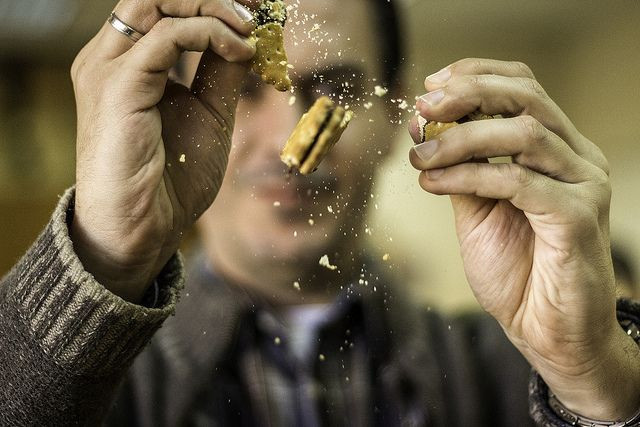Food Cravings Subside With Cognitive Strategy; Kids More Prone To Unhealthy Temptation

If you want to put your food cravings to bed, you have a couple options. The first, research is finding, is simply to grow up. The older you are, and therefore the more developed your brain, the less likely you are to give in to sudden, sugary desires. The other option, unfortunately, requires a bit more effort.
A new study from Columbia University suggests the cognitive strategy of imagining food without its usual properties of taste, smell, and nearness to your gaping, salivating mouth, can help cut cravings by 16 percent. If employed correctly, the added mindfulness could help you to eat less, or at least less of the unhealthy stuff.
Columbia psychologists found kids were especially responsive to this strategy, which needed minimal time to yield an effect. “If children as young as 6 can learn to use a cognitive strategy after just a few minutes of training, that has huge implications for interventions,” said lead researcher and psychological scientist Jennifer A. Silvers in a statement.
One-by-one Silvers and her team put 105 people, aged 6 to 23, into an fMRI. They showed them pictures of salty and sugary foods, designed to get their appetites churning. Half the group was told to imagine the foods were nearby, and to visualize how the food tasted and smelled. The other half was told to imagine the food was far away, and only to think about things like its shape and what color it was.
After viewing each picture, they rated their desire for certain foods. The cognitive strategy group showed significantly weaker cravings for the snacks when they were imagined out-of-reach and divorced from their deliciousness. Telling to the researchers was that even among the two groups, children showed stronger residual cravings than adults. Brain imaging revealed their lateral prefrontal cortexes, responsible for self-control, lit up more than the adults’ did. Meanwhile, their ventral striatum, in charge of reward processing, stayed quiet.
“Having this basic knowledge in hand is critical if we want to understand how our relationship with food changes across the lifespan,” Silvers said.
She hopes to take the knowledge gleaned from this study in a number of different directions. Up next is a longitudinal study, designed to assess changes in food cravings and regulation of cravings all within the same individuals. Silvers and her team also want to bring the cognitive strategy to the classroom, to see if students can harness its benefits not just in a lab but in real-world environments.
A large part of the team’s motivation is born out of epidemiology. Childhood obesity in the U.S. has ballooned to epidemic rates. Data from the Centers for Disease Control and Prevention show rates among children (ages 6 to 11) have doubled over the last 30 years and quadrupled among adolescents (12 to 19). In 1980, only seven percent of children were clinically obese. By 2012, that rate had risen to 18 percent. Adolescent rates shot up from five percent to 21.
Interestingly, children with a higher body mass index in Silvers’ study showed a stronger decline in prefrontal cortex activity when they employed the cognitive strategy. This suggested age wasn’t the only mediating factor in determining cravings; there was something about body mass that may explain the brain’s behavior.
“We believe this research has implications for a wide range of people,” said Silvers, “from basic scientists who are interested in how reward processing changes across the lifespan, to obesity researchers looking to devise interventions to curb childhood obesity, to parents and pediatricians trying to raise healthier and happier kids.”
Source: Silvers J, Insel C, Powers A, et al. Behavioral and Brain Evidence That Children Regulate Craving When Instructed to Do So but Have Higher Baseline Craving Than Adults. Psychological Science. 2014.
Published by Medicaldaily.com



























